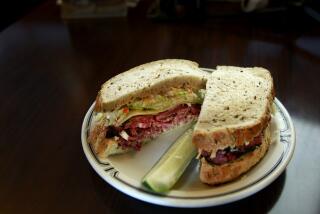Miracle on 34th Street Ends : Psst--Don’t Tell Macy’s! Gimbels Is Closing Down
- Share via
NEW YORK — Macy’s no longer has to keep its secrets from Gimbels. After 76 years of a fierce but friendly rivalry, Gimbels at Herald Square is going out of business.
Gimbels, featured in the classic 1947 Christmas film, “Miracle on 34th Street,” will close before the end of the year and its site will be redeveloped, The New York Times reported today.
A six-month search for a buyer to continue to operate the famous outlet and its 86th Street branch as department stores was fruitless, and the owners will sell both properties to a real estate developer, the newspaper said.
Gene Russell, a spokesman for Batus Inc., which has owned the Gimbels chain since 1973, said company officials would not comment on the report. The report said 5,000 employees would be put out of work in the metropolitan area if the closings spread throughout the chain.
Once-Fierce Rivalry
The once fierce rivalry between Gimbels and Macy’s in Manhattan left behind the phrase, “Does Macy’s tell Gimbels?”--a warning against giving secrets to the competition.
There are many theories on the origin of the slogan, but according to the book, “Macy’s, Gimbels and Me,” by Bernice Fitz-Gibbons, comedian Eddie Cantor coined it in a comedy skit.
The competition between the two famous department stores was popularized in “Miracle on 34th Street,” in which Macy’s Kris Kringle would steer customers to Gimbels for better prices or selection.
According to a Gimbels historian, former company chairman Bernard Gimbel was asked to play Kris Kringle in the movie but turned down the role to actor Edmund Gwenn.
Started by Immigrant
Gimbels was started by a Bavarian immigrant named Adam Gimbel, who wandered the Mississippi River peddling bolts of cloth and hairpins to frontier women.
In 1842 he opened a wood-fronted pot and lace shop near the Wabash River in Vincennes, Ind.
The first store to carry the Gimbel name opened in Milwaukee in 1887, followed by a store in Philadelphia in 1894.
One of Adam’s sons, Bernard--one of 14 children, seven of whom became the famous Gimbel Bros.--brought the Gimbel name to New York in 1910. He erected a 10-story emporium with three basement levels, boasting nearly a million square feet of floor space at 34th Street and Broadway.
Bernard was convinced that a large new store could successfully compete with the already well-established Macy’s despite the worries of his six brothers that it was too large a gamble.
Bought Saks Chain
Under Bernard’s leadership, new stores were opened in several cities and the Saks Fifth Avenue chain was acquired in 1923.
Bruce Gimbel, the great-grandson of the founder, took over as chief executive of Gimbel Bros. in 1961. Before selling to Batus, he opened a second Manhattan store on East 86th Street in the early 1970s in an attempt to cater to the more affluent Upper East Side clientele.
“But as Macy’s changed with the times and geared itself to a more affluent, sophisticated consumer, Gimbels apparently didn’t quite get the signal,” according to Fabian Linden, director of the Consumer Research Center of the Conference Board, who said the merchandise remained “dreary.”
More to Read
Inside the business of entertainment
The Wide Shot brings you news, analysis and insights on everything from streaming wars to production — and what it all means for the future.
You may occasionally receive promotional content from the Los Angeles Times.









